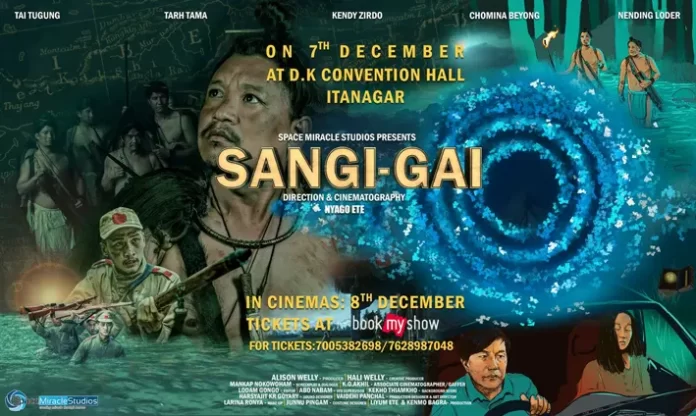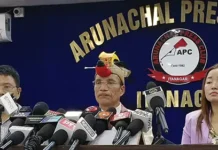[ Bengia Ajum ]
The multilingual film Sangi-Gai, which hit screens across the state on Friday, is fast becoming the talk of the town.
Directed by Nyago Ete and produced by Alison Welly, the film is capturing the imagination of the people of the state with the makers releasing catchy trailers prior to its release.
Welly had earlier produced the very popular film Itanagar 0 Km, which was directed by Tai Gungte, and it had brought stardom to its leading male actor Tai Tugung. In Sangi-Gai, Tugung once again plays the lead protagonist, along with Tarh Tama and Kendy Zirdo.
The first part of the story revolves around 1905, and then it fast-forwards to 2019. The film is about a man named Tamar (Tarh Tama), who is transported to 2019 directly from 1905 by a mysterious object. Tamar, who is searching for his missing brother, stumbles upon a mysterious object which was left by Chinese soldiers in Sangi-Gai after the villagers killed them for entering their territory. Tama is helped by Tugung and Riter, played by Kendy Zirdo in his attempt to go back to his village. Sangi-Gai is an imaginary village, located between Parsi-Parlo and Taksing.
Director Nyago Ete has picked up a very difficult story, which many Arunachalis will find difficult to relate to. But the first half of the film takes us back to our forefather’s era, and it was kind of like getting educated about our past. Sangi-Gai is different from most of the local movies produced in Arunachal because it uses three languages: Nyishi, Hindi and English as mediums. Also, within the Nyishi community, the people of Papum Pare, East Kameng and Kurung Kumey speak with different accents, and in Sangi-Gai, all the three accents have been used. The makers deserve huge appreciation for it.
The special effects in the film by Abo Nabam are of high quality. Where the movie lacks is in its failure to create spark among the actors. There is huge expectation, considering that it is star-studded with actors like Tai Tugung, Kendy Zirdo, Chomina Beyong, and others. More could have been extracted from these highly talented individuals.
Special mention goes to background score composer Kekho Thiamkho and costume designer Junnu Pingam. Both have done excellent work, in particular Pingam, whose costume work gave authentic looks to the actors.
There is a scene in the movie where Tamar, Riter and Tugung sit near the riverside and Tamar starts to sing a Nyishi folksong. The scene, along with the background score, moved many in the theatre. Sangi-Gai is a way-forward movie as it shows the kind of talent and potential that Arunachal’s film industry has to offer. It is not a perfect movie and there is room for improvement in so many segments. But purely for the brave attempt of its makers, the movie deserves to be rated 7 out of 10. Every Arunachali should go to the nearest theatre and watch Sangi-Gai.



